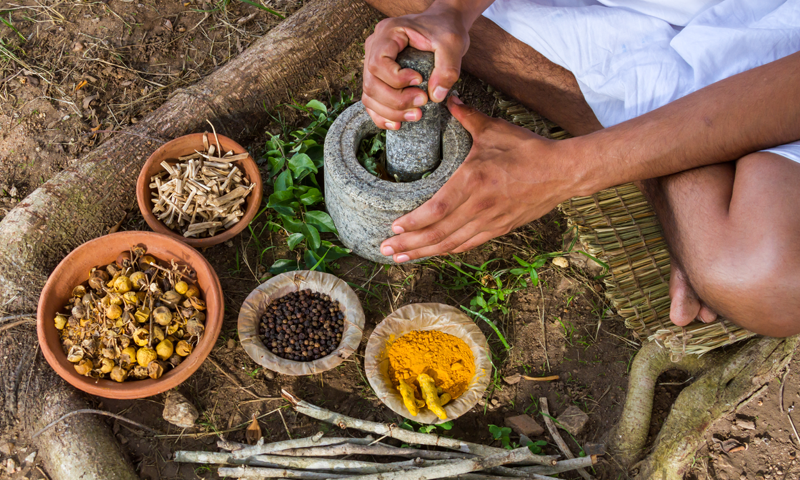
3 Mantras to Build Your Self-Love
7th November 2019
Yoga: The Power of Breath for Physical and Emotional Balance
14th November 2019The Beautiful Symbiosis Between Ayurveda and Yoga

Ayurveda and Yoga go hand in hand. Originating from the same Veda, both are sciences of life and longevity and teach us the power and cycles of nature and the elements. If we use Ayurveda and Yoga to live by the rules of nature, our life will be healthy, happy and peaceful.
While the sciences are similar, Ayurveda concentrates on the physical and mental well-being while Yoga focuses on the mental and spiritual. However, putting on your yoga pants regularly can also promote a strong and flexible body. Yogic texts state that “the foundation of Yoga should be Ayurveda and the fruit of Ayurveda should be Yoga.” Essentially, Ayurveda supports the yogic way and vice-versa. When used together, the practices complement each other and become a complete science. For a healthy body and mind, we should avoid separating the mind and spirit from the physical body. To become a holistic individual, we must take care of both simultaneously. In this article, we explore the beautiful symbiosis between Ayurveda and Yoga in more detail.
What is Yoga?
New Yoga disciplines seem to pop up every day. However, they all stem from the original form of Yoga – Ashtanga. Ashtanga Yoga is built on the eight-folded path through Yoga, or the path to enlightenment. This path includes the rules of personal behaviour, social behaviour, the asanas, the pranayamas, control of the mind and senses, concentration, meditation and the complete union. The first four steps are considered by most practitioners, but the last 4 are only achieved by true yogis. When translated from Sanskrit, the word Yoga means “union”. While some yogis interpret this as union with the divine, others believe it to be the union of the mind, body and spirit.
What is Ayurveda?
Many scholars consider Ayurveda to be the oldest healing science. When translated from Sanskrit, Ayurveda means “the science of life”. The science originated in the East around 5000 years ago and is often referred to as “the mother of all healing”. It stems from the ancient Vedic culture and was originally taught orally by Ayurveda masters to their disciples. While some of this information was set to print, most of it is inaccessible today. Because of this, the practice has been passed on through word of mouth. Ayurveda is now popular worldwide, with many of the natural healing systems deriving from the science, including Polarity Therapy and Homeopathy. Ayurveda also comprises of the “Ashtanga”, with the eight branches being ear, nose and throat diseases, surgery, general medicine, paediatrics, toxicology, psychiatry, rejuvenation through vajikarana and rejuvenation through rasayana.

The Symbiosis
Ayurveda and Yoga go hand in hand. It is believed that the author of the yogic writings, Pantanjali, and the author of the Ayurvedic writings, Charaka, is one and the same person.
So, how do Yoga and Ayurveda work together? Both sciences aim to balance the body and heal any problems or health conditions. It is believed that all of our issues originate from the misuse of energy. Yoga reverses our spiritual and psychological problems and helps to calm the mind and consciousness. At the same time, the practice strengthens our self-confidence and vitality. Ayurveda, on the other hand, treats physical conditions through nutrition, herbal remedies, purification of the organism, massages and other natural healing methods. Essentially, Yoga targets the psychological and spiritual body while Ayurveda targets the physical – with some overlap between the two. However, both practices work in the same way. If you’re suffering from a health condition, Ayurveda pacifies the disturbed dosha through nutrition and herbal remedies while Yoga uses asanas and meditation to rebalance the dosha.
An example: someone with a disturbed Pitta dosha should avoid overheating. Yoga would treat the condition by calming the mind and using cooling asanas like Wide-Legged Forward Bend. At the same time, Ayurveda would cool the body with various herbs and would recommend cooling foods such as coriander, coconut, cucumber and avocado.
Why do we Need to Combine the Two?
While Yoga and Ayurveda can be practised separately, they’re most effective when used together. Through Yoga alone, we will not become “whole” if we eat the wrong foods, lead an inadequate lifestyle and find ourselves imbalanced. Since many illnesses are psychosomatic, we’ll often find relief after 1 hour of practice. However, to continue to improve on a therapeutic level the integration of Ayurveda is essential. This means that we must acknowledge our personal requirements and live by the rules of our nature. We can only achieve a healthy and stable base by connecting with our self on a deeper level. While the mind plays an important role, we must follow an integrative path for best results and thus combine Ayurveda and Yoga. Ayurveda leads us on our path to self-healing, Yoga to self-realisation.
In Summary
So, there you have it – the beautiful symbiosis between Ayurveda and Yoga. Both sciences aim to balance the body and heal any issues or health concerns. As most of our issues originate from the misuse of energy, the practices work together to restore harmony. Yoga calms the mind and reverses our spiritual and psychological problems, while Ayurveda treats physical concerns through herbal remedies, nutrition, purification of the organism, massages and other natural healing methods. Of course, Yoga also increases strength and flexibility in the body, but that isn’t the primary goal of the practice. For best results, use Yoga and Ayurveda simultaneously for a healthy body and mind. If you’re new to Yoga, you may benefit from joining a local class. There, an experienced instructor can advise you on the best way to practice. Before your first session, pack your yoga bag with a mat and a fresh bottle of water to turn up prepared.

